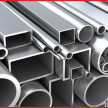FLANGES AND THEIR TYPES
Flanges And How Do They Work

WHAT IS FLANGE?
A flange is a method of connecting pipes, valves, pumps and other equipment to form a piping system. It also provides easy access for cleaning, inspection or modification. Flanges are usually welded or screwed. Flanged joints are made by bolting together two flanges with a gasket between them to provide a seal. flanges are the second most used joining method after welding
In most cases, there are specific gasket and bolting materials made from the same, or approved materials as the piping components you wish to connect. Stainless Steel flanges are some of the most common. However, flanges are available in a wide range of materials so matching them with your needs is essential.
Other common flange materials include Monel, Inconel, Chrome Moly, and many others depending on the application.
TYPES OF FLANGES
SLIP-ON FLANGES :
The slip-on flange is slipped over the pipe and welded (generally both inside and outside) to give quality and prevent spillage. Slip-on Flanges are at the minimal effort end of the scale and don't require high precision when slicing the pipe to length. This slip-on can here and there have a manager or centre point and can be made with a drag to suit either pipe or tube.
they are very common and are available in a large range of sizes to accommodate systems with higher flow rates and throughput. Simply match the flange to the outer diameter of the pipe you intend to connect. Installation is slightly more technical as you’ll need fillet weld on both sides to secure the flange to the pipe.
WELD NECK FLANGES :
Weld neck flanges are one of the most commonly used flanges in the piping industry. They are easy to recognize at the long tapered hub, which goes gradually over to the wall thickness from a pipe or fitting.
The long tapered hub provides an important reinforcement for use in several applications involving high pressure, sub-zero and/or elevated temperatures. The smooth transition from flange thickness to pipe or fitting wall thickness effected by the taper is extremely beneficial, under conditions of repeated bending, caused by line expansion or other variable forces.
Like lap joint flanges, weld neck flanges require butt welding for installation. However, their integrity, performance in systems with multiple repeat bends, and the ability to use them in high-pressure and high-temperature systems make them a leading choice for process piping.
BLIND FLANGES :
Used for terminating or isolating piping systems, blind flanges are essentially boltable blank discs. When installed properly and combined with the correct gaskets, they can achieve an outstanding seal that is easy to remove when needed.
A blind flange is a solid disk used to block off a pipeline or to create a stop. Similar to a regular flange, a blind flange has mounting holes around the perimeter and the gasket sealing rings are machined into the mating surface. The difference is that a blind flange has no opening for fluids to pass through. Instead, it is placed in between two open flanges, which stops the flow through a pipe. Many times this type of blockade is used when adding another line onto an existing pipeline or when a new valve is being added.
Blind flanges are commonly used in petrochemical, pipe engineering, public services and waterworks.
Steel Blind Flanges like Stainless Steel Blind Flanges, Alloy Steel Blind Flanges, Carbon Steel Blind Flanges, Nickel Alloys Blind Flanges, Monel Steel Blind Flanges and Duplex Steel Blind Flanges. Steel Blind Flanges incorporate lots of kinds, which has no drag and is utilized to close the piping framework. When you open a piping framework and Steel Blind Flanges additionally allows simple access to a line once it has been shut. The low weight pipe framework be reached by threaded/screwed.
SOCKET WELD FLANGES :
Ideal for smaller pipe diameters in low-temperature and low-pressure scenarios, socket-weld flanges feature a connection in which you place the pipe into the flange and then secure the connection with a single multi-pass fillet weld. This makes this style simpler to install than other welded flange types while avoiding the limitations associated with threaded ends.
Their static strength is equal to Slip-On flanges, but their fatigue strength 50% greater than double-welded Slip On flanges.
The purpose of the bottoming clearance in a Socket Weld is usually to reduce the residual stress at the root of the weld that could occur during the solidification of the weld metal.
Steel Socket Flanges like Stainless Steel Socket Flanges, Alloy Steel Socket Flanges, Carbon Steel Socket Flanges, Nickel Alloys Socket Flanges, Monel Steel Socket Flanges and Duplex Steel Socket Flanges.
Steel Socket Welding flanges are like slip-on flange, same to attachment welding flange, however, the drag is counter-exhausted to acknowledge pipe. The distance across the remaining bore is the same as within the measurement of the pipe. The Steel Socket Welding Flange is joined to the pipe by a filet weld around the centre of the flange. An optional interior weld might be connected in high stretch applications. The greatest utilization of Socket Flanges is in high weight frameworks, for example, pressure-driven and steam lines.
Conclusion
In this article, I have tried to explain the term Flange. And their different types with their characteristics and where they mostly used.
About the Creator
Pipeline Solutions
Pipeline Solutions Pvt. Ltd. Are The Well Known Manufacturers, Exporters And Stockist Of Quality Steel Products Pipe Fittings, Flanges, Fasteners, Valves, Gaskets, Pipes & Tubes, Nipple & Other Products.






Comments
There are no comments for this story
Be the first to respond and start the conversation.